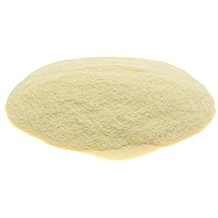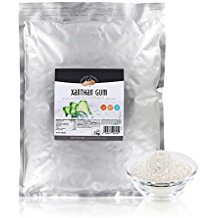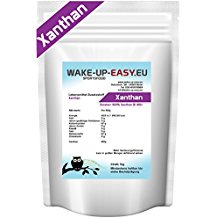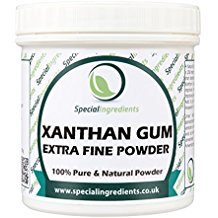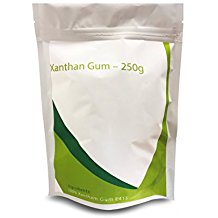La gomme xanthane est un polyoside obtenu à partir de l'action d'une bactérie, la Xanthomonas campestris. Elle est soluble à froid et est utilisée comme additif alimentaire sous le code E415 pour ses propriétés épaississantes et gélifiantes afin de modifier la consistance des aliments.
Amazon France
Le xanthane est l'un des exopolysaccharides excrétés par divers microorganismes du sol (bactéries notamment). Il joue un rôle important, à l'échelle moléculaire, dans la formation et la conservation des sols, tout comme le dextrane, le rhamsane ou les succinoglycanes.
La gomme xanthane a été découverte par Allene Rosalind Jeanes du département américain de l'agriculture, lors de la recherche sur les biopolymères et leurs utilisations potentielles.
Elle a été commercialisée dans les années soixante par l'entreprise Kelco Company sous la marque Kelzan.
Depuis elle est acceptée comme un additif alimentaire sans danger pour la consommation par les États-Unis, le Canada et l'Europe.
En 1986, le JECFA a établi une dose journalière admissible (DJA) non spécifié pour la gomme xanthane indiquant que son utilisation dans les aliments dans les proportions requises pour obtenir l'effet désiré ne présente pas de danger pour la santé humaine.
La gomme xanthane est un polyoside ramifié. Il est constitué d'une combinaison de quatre composés : le glucose, le mannose, l'acide glucuronique et l'acide pyruvique.
Propriétés chimiquesModifier
Contrairement aux autres gommes naturelles, la gomme xanthane est stable en milieu acide.
Propriétés physiquesModifier
La gomme xanthane est une poudre blanchâtre inodore et insipide. Elle est soluble à froid dans l’eau, dans le lait et insoluble dans l'alcool.
Autres propriétésModifier
La gomme xanthane est une gomme à fort pouvoir épaississant et suspensif, qui permet l'obtention de solutions à forte viscosité. Ces suspensions sont très peu influencées par la température et supportent très bien la congélation et la décongélation. Elle possède une faible synergie avec la gomme de guar.
Le mélange obtenu est purifié avec de l'éthanol ou de l'isopropanol, séché et moulu. Des sels neutres sodiques, potassiques ou calciques sont aussi produits pour des fins commerciales.



